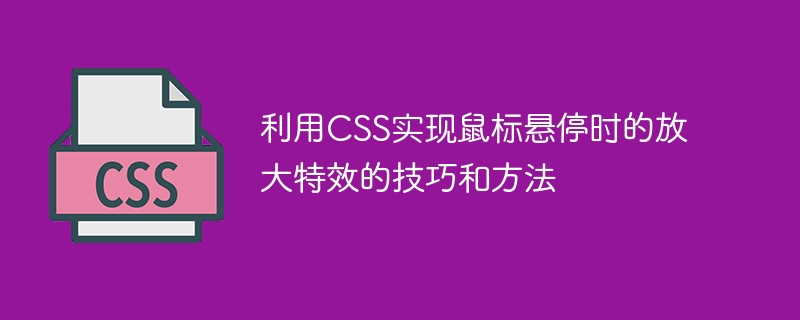

Techniques and methods of using CSS to achieve the amplification effect when the mouse is hovering
The amplification effect when the mouse is hovering is a common web page animation effect that can be used for Add interactivity and appeal to web pages. This article will introduce some techniques and methods to achieve this special effect, and provide specific CSS code examples.
The transform attribute of CSS can achieve transformation effects such as scaling, rotation, tilt and translation of elements. We can use the scale() function to achieve the magnification effect when the mouse is hovering.
First, add a class to the element that needs to be animated, such as "zoom-effect". Then, use the :hover pseudo-class selector to define the style on mouseover.
The sample code is as follows:
.zoom-effect { transition: transform 0.3s ease; } .zoom-effect:hover { transform: scale(1.2); }
In the above code, we use the transition attribute to add a transition effect to the animation. Then, use the transform attribute in the :hover pseudo-class selector to achieve the magnification effect, where scale(1.2) means to magnify the size of the element to 1.2 times its original size.
In addition to simple element enlargement, we can also add some shadow effects while enlarging to increase the three-dimensionality of the element. and layering.
The sample code is as follows:
.zoom-effect { transition: transform 0.3s ease, box-shadow 0.3s ease; } .zoom-effect:hover { transform: scale(1.2); box-shadow: 0 0 10px rgba(0, 0, 0, 0.3); }
In the above code, we added a box-shadow attribute in the :hover pseudo-class selector to add the shadow effect of the element, where 0 0 10px represents the position and size of the shadow, and rgba(0, 0, 0, 0.3) represents the color and transparency of the shadow.
By adjusting the parameters of the transition attribute, we can change the transition time and speed curve of the animation, thereby adjusting the effect of the animation.
The sample code is as follows:
.zoom-effect { transition: transform 0.5s cubic-bezier(.25,.1,.25,1.4); } .zoom-effect:hover { transform: scale(1.2); }
In the above code, we use the cubic-bezier() function to define a custom speed curve. By adjusting the Bezier control points of the curve, we can Achieve more complex transition effects.
Using the above techniques and methods, we can easily achieve the magnification effect when the mouse is hovering, adding a sense of dynamics and attraction to the web page. At the same time, by adjusting parameters and combining other features, we can also achieve more unique and rich animation effects. Hope this article helps you!
The above is the detailed content of Tips and methods to use CSS to achieve amplification effects when the mouse is hovering. For more information, please follow other related articles on the PHP Chinese website!




